|
Click below to see archival footage of excavations at Tell Madaba in 2008 (forthcoming).
In keeping with the Tall Mādabā Archaeological Project (TMAP) objective to map
architecture and assemble quantifiable artifact assemblages for each of the principal phases of
occupation at the site, the 2008 field season saw a continuation of the excavations begun in
1998 along the west acropolis (Field B; see Figure 2) (Harrison et al. 2003; Foran et al.
2004). The primary objectives of the 2008 TMAP field season, therefore, were 1) to reopen
one unit in order to expose more of the Hellenistic and Iron Age levels present on the site; 2)
to explore more of the Early Roman/Nabatean and Hellenistic structures in one new unit
adjacent to the main excavation area; and 3) to open one new unit inside the Late Ottoman
house on the southern edge of the site. In addition to excavation, time and resources were
also devoted to improving the overall appearance of the site and assuring the protection of
these remains after the field season.
The 2008 season was conducted between June 15 and July 24, with the author acting
as Project Director. An archaeological field school for students from the University of
Toronto was also run in conjunction with the 2008 field season. Ali al-Khayyat served as
the Department of Antiquities representatives.
Excavations have been ongoing in Field B since 1998, and in that time deposits dating
to the Late Ottoman (FP 1), Late Byzantine/Early Islamic (FP 2), Early Roman/Nabataean
(FPs 3 and 4), Late Hellenistic (FPs 5 and 6), Late Iron IIB (FP 7), Iron IIB (FP 8), Iron I/Iron
IIA (FP 9), and Late Bronze/ Iron IA (FP 10) periods have been exposed. As stated above,
the primary goal of the 2008 season was to further investigate the extent of remains dating to
the Early Roman/Nabataean, Hellenistic, and Iron Age periods on this area of the tall. To this
end, one unit (Square 5M11B4) at the south-eastern corner of the previously excavated area,
and to the east of the large fortification wall, was reopened and two new units (Squares
5M11Q2 and 5M21V4) were opened.
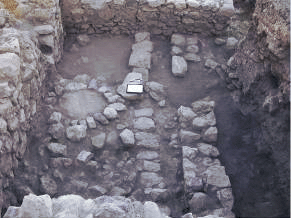 At the end of the 2007 field season, an east-west running wall(5M11B4:33) and a large cobbled surface (5M11B4:35) dating to the Late Hellenistic period(FPs 5 & 6) had been exposed (image left). In addition, a circular, stone-built installation at the
western edge of the cobbled area had been uncovered. An area was also excavated in the gap at the western end of the east-west wall in which a small portion of a hard-packed plaster surface was exposed. At the end of the 2007 field season, an east-west running wall(5M11B4:33) and a large cobbled surface (5M11B4:35) dating to the Late Hellenistic period(FPs 5 & 6) had been exposed (image left). In addition, a circular, stone-built installation at the
western edge of the cobbled area had been uncovered. An area was also excavated in the gap at the western end of the east-west wall in which a small portion of a hard-packed plaster surface was exposed.
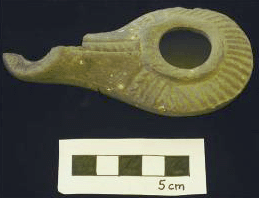 The initial goal for the 2008 season in 5M11B4 was to complete the exposure of the Late Hellenistic (FPs 5 & 6) material present in this excavation unit. A series of superimposed plaster surfaces (5M11B4:38, 49, 57, 64) were discovered. The material
recovered from these surfaces clearly date them to the Late Hellenistic period. They surely represent various occupation phases within this field phase. It appears that in addition to laying new surfaces within this structure, the inhabitants also used small, one-row walls to subdivide the space. Two such walls (5M11B4:40, 46) were uncovered in this
excavation unit (image below - left). The circular, stone-built installation at the western edge of the cobbled area exposed
in 2007 was completely excavated and removed during the 2008 season (image below - right). The initial goal for the 2008 season in 5M11B4 was to complete the exposure of the Late Hellenistic (FPs 5 & 6) material present in this excavation unit. A series of superimposed plaster surfaces (5M11B4:38, 49, 57, 64) were discovered. The material
recovered from these surfaces clearly date them to the Late Hellenistic period. They surely represent various occupation phases within this field phase. It appears that in addition to laying new surfaces within this structure, the inhabitants also used small, one-row walls to subdivide the space. Two such walls (5M11B4:40, 46) were uncovered in this
excavation unit (image below - left). The circular, stone-built installation at the western edge of the cobbled area exposed
in 2007 was completely excavated and removed during the 2008 season (image below - right).
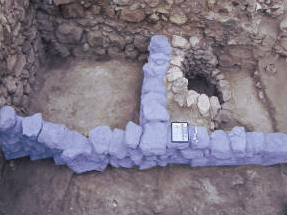 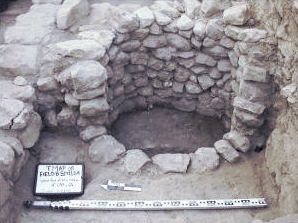 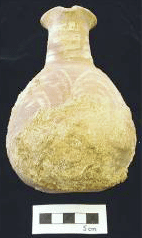 This effort revealed that although the well (5M11B4:43) was built during the Late Hellenistic period, its last reuse was during the Late Byzantine/Early Islamic period. The material culture extracted from this installation can be securely dated to the 7th century CE. Objects retrieved included a small tri-foil-mouthed juglet (right).
Two large walls are located in the eastern and southern baulks of this excavation unit(5M11B4:17, 27). The bases and foundation trenches for these walls were excavated this season, confirming a Late Hellenistic date for the initial construction of the associated
structure. This effort revealed that although the well (5M11B4:43) was built during the Late Hellenistic period, its last reuse was during the Late Byzantine/Early Islamic period. The material culture extracted from this installation can be securely dated to the 7th century CE. Objects retrieved included a small tri-foil-mouthed juglet (right).
Two large walls are located in the eastern and southern baulks of this excavation unit(5M11B4:17, 27). The bases and foundation trenches for these walls were excavated this season, confirming a Late Hellenistic date for the initial construction of the associated
structure.
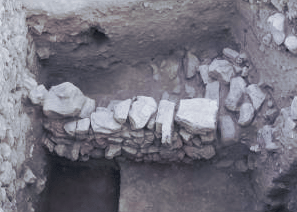 Once the extent of Late Hellenistic occupation in 5M11B4 had been exposed, excavation continued in an effort to expose the earlier Iron Age occupation present elsewhere on the site. Based on the results from the two units that have the most substantial Iron Age remains (5M21U4 & 5M21V3), it was assumed that a layer of sheetwash (5M21V3:91)would form a barrier between the Hellenistic and Iron Age material. This particular depositional event is completely absent from 5M11B4, indicating perhaps that the city’s massive fortification wall was responsible for this accumulation in the other trenches. Further excavation in 5M11B4 did, however, produce more evidence of a Late Iron IIB ‘squatter’ occupation phase (FP 7) that has been well-documented in previously
excavated areas. A north-south wall (image left) (5M11B4:96) was exposed along with an associated
occupational surface (5M11B4:119). Various layers of mudbrick detritus (e.g.5M11B4:111) indicate that this particular occupation phase was abandoned, fell intodisrepair, and collapsed. Excavations in 5M11B4 will hopefully continue in future field seasons in order to
expand our knowledge of the Iron Age occupation phases on Madaba’s west acropolis. Once the extent of Late Hellenistic occupation in 5M11B4 had been exposed, excavation continued in an effort to expose the earlier Iron Age occupation present elsewhere on the site. Based on the results from the two units that have the most substantial Iron Age remains (5M21U4 & 5M21V3), it was assumed that a layer of sheetwash (5M21V3:91)would form a barrier between the Hellenistic and Iron Age material. This particular depositional event is completely absent from 5M11B4, indicating perhaps that the city’s massive fortification wall was responsible for this accumulation in the other trenches. Further excavation in 5M11B4 did, however, produce more evidence of a Late Iron IIB ‘squatter’ occupation phase (FP 7) that has been well-documented in previously
excavated areas. A north-south wall (image left) (5M11B4:96) was exposed along with an associated
occupational surface (5M11B4:119). Various layers of mudbrick detritus (e.g.5M11B4:111) indicate that this particular occupation phase was abandoned, fell intodisrepair, and collapsed. Excavations in 5M11B4 will hopefully continue in future field seasons in order to
expand our knowledge of the Iron Age occupation phases on Madaba’s west acropolis.
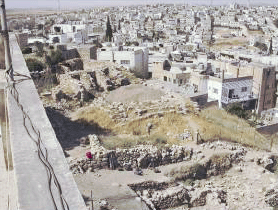 In order to explore the extent of ancient occupation, square 5M11Q2 was
opened inside the large Late Ottoman house located on the southern edge of the site (image left). After the removal of several layers of recent modern garbage, excavation in this unit
began by clearing the occupational surface (5M11Q2:21) associated with the extant Late
Ottoman architecture (FP 1). The layout of this particular area of the building and the
artefacts found in association with the living surface suggest that it was used to stable horses.
Excavation beneath this surface immediately revealed material associated with the
Late Hellenistic (FPs 5 & 6) occupation at Tall Madaba. As has been noted elsewhere, the
construction activity connected to the reoccupation of Madaba in the late 19th century resulted
in the destruction of most of the remains from the Late Byzantine/Early Islamic and Early
Roman/Nabataean periods. Two north-south walls (5M11Q2:22, 36) were exposed and their
respective foundation trenches (5M11Q2:40/42, 39/41) confirm that they were built in the
later occupation phase (FP 5) dating to the Late Hellenistic period (image right). In order to explore the extent of ancient occupation, square 5M11Q2 was
opened inside the large Late Ottoman house located on the southern edge of the site (image left). After the removal of several layers of recent modern garbage, excavation in this unit
began by clearing the occupational surface (5M11Q2:21) associated with the extant Late
Ottoman architecture (FP 1). The layout of this particular area of the building and the
artefacts found in association with the living surface suggest that it was used to stable horses.
Excavation beneath this surface immediately revealed material associated with the
Late Hellenistic (FPs 5 & 6) occupation at Tall Madaba. As has been noted elsewhere, the
construction activity connected to the reoccupation of Madaba in the late 19th century resulted
in the destruction of most of the remains from the Late Byzantine/Early Islamic and Early
Roman/Nabataean periods. Two north-south walls (5M11Q2:22, 36) were exposed and their
respective foundation trenches (5M11Q2:40/42, 39/41) confirm that they were built in the
later occupation phase (FP 5) dating to the Late Hellenistic period (image right).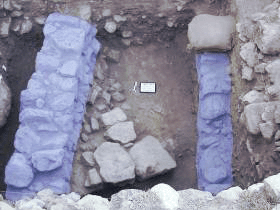 Remnants of
a plaster surface (5M11Q2:34) beneath the foundation levels of these walls attest to the
presence of an earlier Late Hellenistic occupation (FP 6) at this location.
As work continued in this square, a large wall (5M11Q2:44) built of massive stones
was uncovered in its northern half (see below). The loci associated with the base of this
structure have been dated to the Iron II period. A cobble platform (5M11Q2:54) to the south
of the wall may represent the living surface associated with this architecture; however, it had
been seriously disturbed by later building activity and thus its precise function remains
ambiguous. Based on the material recovered from the soil layers sealing against this
architecture and its elevation in relation to other excavated structures, this wall most likely
dates to the Iron IIB period (FP 8) which is represented by two pillared buildings elsewhere
on site. Remnants of
a plaster surface (5M11Q2:34) beneath the foundation levels of these walls attest to the
presence of an earlier Late Hellenistic occupation (FP 6) at this location.
As work continued in this square, a large wall (5M11Q2:44) built of massive stones
was uncovered in its northern half (see below). The loci associated with the base of this
structure have been dated to the Iron II period. A cobble platform (5M11Q2:54) to the south
of the wall may represent the living surface associated with this architecture; however, it had
been seriously disturbed by later building activity and thus its precise function remains
ambiguous. Based on the material recovered from the soil layers sealing against this
architecture and its elevation in relation to other excavated structures, this wall most likely
dates to the Iron IIB period (FP 8) which is represented by two pillared buildings elsewhere
on site.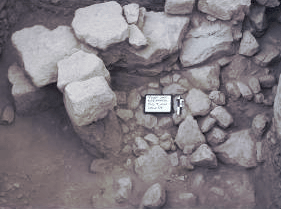 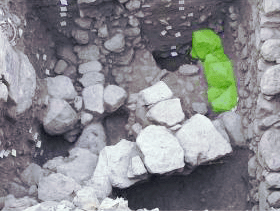
These results imply that the Late Iron IIB ‘squatter’ phase and the sheetwash layers that sealed above it are not present on this area of the site, or perhaps they were removed by
the construction projects undertaken in the Late Hellenistic period.
A small sondage was conducted along the western end of the southern baulk at the
end of the season. A small wall (5M11Q2:67) was exposed and may indicate the presence of
an earlier occupation phase in this square (see above right). The large amount of cooking pots that
were recovered suggest that this earlier structure was domestic in nature.
It would be beneficial to continue excavation in 5M11Q2; however, this would
seriously undermine the Late Ottoman architecture that surrounds it. The excavation efforts
in this area of the site during the 2008 season have, on the other hand, opened the way for
further exploration with the ruins of this Late Ottoman house.
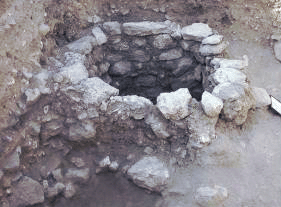 Excavations in 5M21V4 were initiated during the 2008 season in order to
further explore the successive occupation phases present on the site and connect the material
exposed in 5M21W3, to the east, during the 2007 season with remains previously exposed in
5M21V3, to the west. Excavations in 5M21V4 were initiated during the 2008 season in order to
further explore the successive occupation phases present on the site and connect the material
exposed in 5M21W3, to the east, during the 2007 season with remains previously exposed in
5M21V3, to the west.
The occupational sequence in 5M21V4 closely resembles that of other excavational
units on the site. After having removed several layers of modern debris, the remains of a
circular, stone-built installation (5M21V4:4) were exposed (see left)). Although this silo
was most likely built in the Early Roman/Nabataean period, based on the soil loci associated
with it, it was clearly reused in the Late Ottoman period as is evidenced by the material found
within its fill.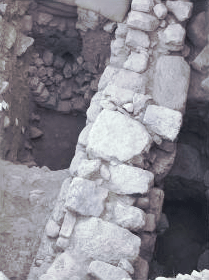 There are no remains dating to the Late Byzantine/Early Islamic left in this
square, a further testament to the disruptive nature of the city’s late 19th century reoccupation.
Once this silo was removed, a substantial wall (5M21V4:20, 30) dating to the Late
Hellenistic period was exposed (right). The foundation for this wall consists of a onecourse
construction (5M21V4:43) that is slightly wider than the wall itself. This foundation
forms a threshold (5M21V4:31) in the middle of the wall. The material recovered from the
foundation trench (5M21V4:24/25), at the northern end of the west side of the wall, and the
other soil loci that sealed against it confirms the dating of this structure to the Late Hellenistic
period (below). There are no remains dating to the Late Byzantine/Early Islamic left in this
square, a further testament to the disruptive nature of the city’s late 19th century reoccupation.
Once this silo was removed, a substantial wall (5M21V4:20, 30) dating to the Late
Hellenistic period was exposed (right). The foundation for this wall consists of a onecourse
construction (5M21V4:43) that is slightly wider than the wall itself. This foundation
forms a threshold (5M21V4:31) in the middle of the wall. The material recovered from the
foundation trench (5M21V4:24/25), at the northern end of the west side of the wall, and the
other soil loci that sealed against it confirms the dating of this structure to the Late Hellenistic
period (below).
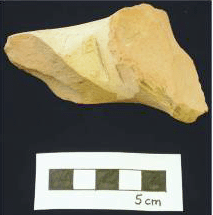 A series of plaster floors (5M21V4:40, 42, 46), similar to those in 5M11B4, were
exposed in this square. The earliest of these can clearly be associated with the construction
of the wall. The western side of 5M21V4:20 is faced with plaster that extends downward to
cover the foundation wall and then levels out forming the floor designated 5M21V4:46
(below). Other features associated with this phase of occupation include a tabun
(5M21V4:38) that was exposed to the east of 5M21V4:20. A series of plaster floors (5M21V4:40, 42, 46), similar to those in 5M11B4, were
exposed in this square. The earliest of these can clearly be associated with the construction
of the wall. The western side of 5M21V4:20 is faced with plaster that extends downward to
cover the foundation wall and then levels out forming the floor designated 5M21V4:46
(below). Other features associated with this phase of occupation include a tabun
(5M21V4:38) that was exposed to the east of 5M21V4:20.
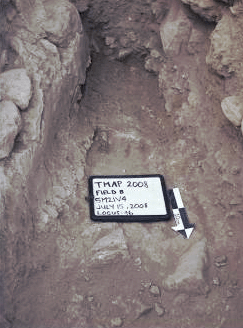
Once the Late Hellenistic layers had been cleared, excavation into the Iron Age
deposits began. Given the presence of a thick layer of sheet-wash that sealed in the Iron Age
levels exposed in 5M21V3 to the west (below left), it was expected that the same depositional
phenomenon would have occurred in 5M21V4. Excavations have revealed, however, that
there is no trace of this sheet-wash on this area of the acropolis. Presumably, taking into
consideration the tell, this material was completely washed away from 5M21V4 and collected
primarily in 5M21V43 and 5M21U4. The city’s massive fortification wall, to the west of
5M21U4, must have played a role in the substantial accumulation in these two squares.
Remains dating to the Late Iron IIB period (FP 7) were recovered from 5M21V4, but
no architecture was exposed. Excavations in this square ended with the exposure of the tops
of structures (5M21V4:51, 55) (below right) that must date to the Iron IIB (FP 8) and are
associated with the pillared buildings in 5M21V3 and 5M21W3. Hopefully, in future season,
excavations will be able to continue in 5M21V4 and more exploration can be done into the
earlier Iron Age phases on the site.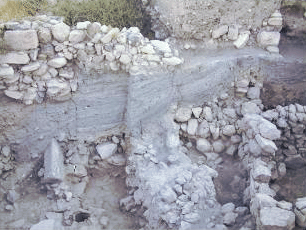 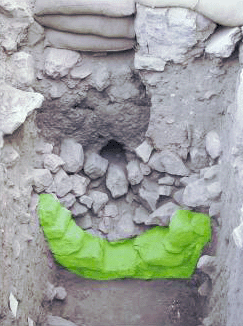
The excavations in Field B during the 2008 season succeeded in providing more
information on almost all of the field phases present in this area of the tall.
The history of the reoccupation of Mādabā during the Late Ottoman period is well
known. The Field B excavations have exposed numerous walls associated with the visible
architecture on the site, in addition to several installations that were surely associated with
these 19th century structures (FP 1).
Efforts during the 2008 season have allowed us to add a
large circular silo at the northern end of the excavated area to this corpus.
The importance of Mādabā during the Byzantine period is indisputable; however, very
little evidence from this phase of occupation (FP 2) had been found in Field B before the
2007 season. A fragmentary mosaic pavement associated with a stone threshold was
uncovered to the east of the previously excavated area. A second feature can now be added
to this field phase. The remains of a silo, first uncovered at the end of the 2007 season,
produced a definitive Late Byzantine/Early Islamic ceramic corpus. This installation was
clearly built at the same time as the Late Hellenistic walls that surround it, but it continued in
use until the 7th or 8th century CE. Although the presence of substantial ceramic material from
both the Late Byzantine/Early Islamic (FP 2) and Early Roman/Nabataean (FP 3 & 4) periods
in Field B testifies to significant occupation at this time, the absence of any major structures
can be explained by the prolific building activity of Mādabā’s new inhabitants in the Late
Ottoman period.
Previous field seasons at Tell Mādabā had exposed the remains of a massive structure
dating to the Late Hellenistic period (FP 5 & 6). This season’s excavations successfully
uncovered more of this building and other contemporary structures. These vestiges confirm
that, during the 3rd and 2nd centuries BCE, a sizeable construction project was undertaken just
inside the pre-classical fortification wall on the western side of the acropolis. In a second
phase, dating to the same cultural period, this building was remodeled and further reinforced.
During the 2007 season, the earliest occupation phase on the west acropolis was
exposed along the inner face of the site’s fortification wall. This provided a clear occupation
sequence that began in the Late Bronze/Early Iron I (FP 10) and continued until the late Iron
IIB (FP 7). The Iron Age remains previously excavated at Tell Madaba were sealed by a
thick layer of sheet-wash. The 2008 excavations have revealed that this post-abandonment
deposit is not present everywhere on site, indicating that perhaps the city’s massive
fortification wall was responsible for this accumulation.
The latest Iron Age phase at Tell Mādabā (FP 7) dates to the late Iron IIB period and
consists of what has been termed a ‘squatter’ occupation. Excavations in 2008 exposed more
of these badly constructed buildings; however, our efforts this season have also confirmed
that this field phase is not present everywhere on the site. The earlier Iron Age phase (FP 8),
dating to the Iron IIB, is represented by pillared buildings in the previously excavated area.
Exploration in 2008 confirmed the extensive nature of the settlement at this time. Remnants
of a massive structure built of very large stones was exposed at the southern end of the site.
The 2008 field season of the Tall Mādabā Archaeological Project have provided
further proof of the city’s importance, not only in the Byzantine period, but also throughout
the Iron Age, Late Hellenistic, Early Roman/Nabataean periods. Our efforts are also
continually contributing to this history of the modern city of Mādabā.
In addition to the Project Director, the staff consisted of Bart Bartholomieux, Robert Cumming, Simon Pond,
Florence Ting, and Bryan Wyshnicki. The student participants were Anne Bedard, Nicole Lowden, Christopher
Melnick-MacDonald, Alexandra Mullan, Gavin Nowlan, Gabriela Rodriguez, Casey Scott-Songin, Madeleine
Shen, Victoria Taxopoulos, Lee Templeton, and Rebecca Weston.
|

 At the end of the 2007 field season, an east-west running wall(5M11B4:33) and a large cobbled surface (5M11B4:35) dating to the Late Hellenistic period(FPs 5 & 6) had been exposed (image left). In addition, a circular, stone-built installation at the
western edge of the cobbled area had been uncovered. An area was also excavated in the gap at the western end of the east-west wall in which a small portion of a hard-packed plaster surface was exposed.
At the end of the 2007 field season, an east-west running wall(5M11B4:33) and a large cobbled surface (5M11B4:35) dating to the Late Hellenistic period(FPs 5 & 6) had been exposed (image left). In addition, a circular, stone-built installation at the
western edge of the cobbled area had been uncovered. An area was also excavated in the gap at the western end of the east-west wall in which a small portion of a hard-packed plaster surface was exposed.
 The initial goal for the 2008 season in 5M11B4 was to complete the exposure of the Late Hellenistic (FPs 5 & 6) material present in this excavation unit. A series of superimposed plaster surfaces (5M11B4:38, 49, 57, 64) were discovered. The material
recovered from these surfaces clearly date them to the Late Hellenistic period. They surely represent various occupation phases within this field phase. It appears that in addition to laying new surfaces within this structure, the inhabitants also used small, one-row walls to subdivide the space. Two such walls (5M11B4:40, 46) were uncovered in this
excavation unit (image below - left). The circular, stone-built installation at the western edge of the cobbled area exposed
in 2007 was completely excavated and removed during the 2008 season (image below - right).
The initial goal for the 2008 season in 5M11B4 was to complete the exposure of the Late Hellenistic (FPs 5 & 6) material present in this excavation unit. A series of superimposed plaster surfaces (5M11B4:38, 49, 57, 64) were discovered. The material
recovered from these surfaces clearly date them to the Late Hellenistic period. They surely represent various occupation phases within this field phase. It appears that in addition to laying new surfaces within this structure, the inhabitants also used small, one-row walls to subdivide the space. Two such walls (5M11B4:40, 46) were uncovered in this
excavation unit (image below - left). The circular, stone-built installation at the western edge of the cobbled area exposed
in 2007 was completely excavated and removed during the 2008 season (image below - right).


 This effort revealed that although the well (5M11B4:43) was built during the Late Hellenistic period, its last reuse was during the Late Byzantine/Early Islamic period. The material culture extracted from this installation can be securely dated to the 7th century CE. Objects retrieved included a small tri-foil-mouthed juglet (right).
Two large walls are located in the eastern and southern baulks of this excavation unit(5M11B4:17, 27). The bases and foundation trenches for these walls were excavated this season, confirming a Late Hellenistic date for the initial construction of the associated
structure.
This effort revealed that although the well (5M11B4:43) was built during the Late Hellenistic period, its last reuse was during the Late Byzantine/Early Islamic period. The material culture extracted from this installation can be securely dated to the 7th century CE. Objects retrieved included a small tri-foil-mouthed juglet (right).
Two large walls are located in the eastern and southern baulks of this excavation unit(5M11B4:17, 27). The bases and foundation trenches for these walls were excavated this season, confirming a Late Hellenistic date for the initial construction of the associated
structure.
 Once the extent of Late Hellenistic occupation in 5M11B4 had been exposed, excavation continued in an effort to expose the earlier Iron Age occupation present elsewhere on the site. Based on the results from the two units that have the most substantial Iron Age remains (5M21U4 & 5M21V3), it was assumed that a layer of sheetwash (5M21V3:91)would form a barrier between the Hellenistic and Iron Age material. This particular depositional event is completely absent from 5M11B4, indicating perhaps that the city’s massive fortification wall was responsible for this accumulation in the other trenches. Further excavation in 5M11B4 did, however, produce more evidence of a Late Iron IIB ‘squatter’ occupation phase (FP 7) that has been well-documented in previously
excavated areas. A north-south wall (image left) (5M11B4:96) was exposed along with an associated
occupational surface (5M11B4:119). Various layers of mudbrick detritus (e.g.5M11B4:111) indicate that this particular occupation phase was abandoned, fell intodisrepair, and collapsed. Excavations in 5M11B4 will hopefully continue in future field seasons in order to
expand our knowledge of the Iron Age occupation phases on Madaba’s west acropolis.
Once the extent of Late Hellenistic occupation in 5M11B4 had been exposed, excavation continued in an effort to expose the earlier Iron Age occupation present elsewhere on the site. Based on the results from the two units that have the most substantial Iron Age remains (5M21U4 & 5M21V3), it was assumed that a layer of sheetwash (5M21V3:91)would form a barrier between the Hellenistic and Iron Age material. This particular depositional event is completely absent from 5M11B4, indicating perhaps that the city’s massive fortification wall was responsible for this accumulation in the other trenches. Further excavation in 5M11B4 did, however, produce more evidence of a Late Iron IIB ‘squatter’ occupation phase (FP 7) that has been well-documented in previously
excavated areas. A north-south wall (image left) (5M11B4:96) was exposed along with an associated
occupational surface (5M11B4:119). Various layers of mudbrick detritus (e.g.5M11B4:111) indicate that this particular occupation phase was abandoned, fell intodisrepair, and collapsed. Excavations in 5M11B4 will hopefully continue in future field seasons in order to
expand our knowledge of the Iron Age occupation phases on Madaba’s west acropolis. In order to explore the extent of ancient occupation, square 5M11Q2 was
opened inside the large Late Ottoman house located on the southern edge of the site (image left). After the removal of several layers of recent modern garbage, excavation in this unit
began by clearing the occupational surface (5M11Q2:21) associated with the extant Late
Ottoman architecture (FP 1). The layout of this particular area of the building and the
artefacts found in association with the living surface suggest that it was used to stable horses.
Excavation beneath this surface immediately revealed material associated with the
Late Hellenistic (FPs 5 & 6) occupation at Tall Madaba. As has been noted elsewhere, the
construction activity connected to the reoccupation of Madaba in the late 19th century resulted
in the destruction of most of the remains from the Late Byzantine/Early Islamic and Early
Roman/Nabataean periods. Two north-south walls (5M11Q2:22, 36) were exposed and their
respective foundation trenches (5M11Q2:40/42, 39/41) confirm that they were built in the
later occupation phase (FP 5) dating to the Late Hellenistic period (image right).
In order to explore the extent of ancient occupation, square 5M11Q2 was
opened inside the large Late Ottoman house located on the southern edge of the site (image left). After the removal of several layers of recent modern garbage, excavation in this unit
began by clearing the occupational surface (5M11Q2:21) associated with the extant Late
Ottoman architecture (FP 1). The layout of this particular area of the building and the
artefacts found in association with the living surface suggest that it was used to stable horses.
Excavation beneath this surface immediately revealed material associated with the
Late Hellenistic (FPs 5 & 6) occupation at Tall Madaba. As has been noted elsewhere, the
construction activity connected to the reoccupation of Madaba in the late 19th century resulted
in the destruction of most of the remains from the Late Byzantine/Early Islamic and Early
Roman/Nabataean periods. Two north-south walls (5M11Q2:22, 36) were exposed and their
respective foundation trenches (5M11Q2:40/42, 39/41) confirm that they were built in the
later occupation phase (FP 5) dating to the Late Hellenistic period (image right). Remnants of
a plaster surface (5M11Q2:34) beneath the foundation levels of these walls attest to the
presence of an earlier Late Hellenistic occupation (FP 6) at this location.
As work continued in this square, a large wall (5M11Q2:44) built of massive stones
was uncovered in its northern half (see below). The loci associated with the base of this
structure have been dated to the Iron II period. A cobble platform (5M11Q2:54) to the south
of the wall may represent the living surface associated with this architecture; however, it had
been seriously disturbed by later building activity and thus its precise function remains
ambiguous. Based on the material recovered from the soil layers sealing against this
architecture and its elevation in relation to other excavated structures, this wall most likely
dates to the Iron IIB period (FP 8) which is represented by two pillared buildings elsewhere
on site.
Remnants of
a plaster surface (5M11Q2:34) beneath the foundation levels of these walls attest to the
presence of an earlier Late Hellenistic occupation (FP 6) at this location.
As work continued in this square, a large wall (5M11Q2:44) built of massive stones
was uncovered in its northern half (see below). The loci associated with the base of this
structure have been dated to the Iron II period. A cobble platform (5M11Q2:54) to the south
of the wall may represent the living surface associated with this architecture; however, it had
been seriously disturbed by later building activity and thus its precise function remains
ambiguous. Based on the material recovered from the soil layers sealing against this
architecture and its elevation in relation to other excavated structures, this wall most likely
dates to the Iron IIB period (FP 8) which is represented by two pillared buildings elsewhere
on site.

 Excavations in 5M21V4 were initiated during the 2008 season in order to
further explore the successive occupation phases present on the site and connect the material
exposed in 5M21W3, to the east, during the 2007 season with remains previously exposed in
5M21V3, to the west.
Excavations in 5M21V4 were initiated during the 2008 season in order to
further explore the successive occupation phases present on the site and connect the material
exposed in 5M21W3, to the east, during the 2007 season with remains previously exposed in
5M21V3, to the west.
 There are no remains dating to the Late Byzantine/Early Islamic left in this
square, a further testament to the disruptive nature of the city’s late 19th century reoccupation.
Once this silo was removed, a substantial wall (5M21V4:20, 30) dating to the Late
Hellenistic period was exposed (right). The foundation for this wall consists of a onecourse
construction (5M21V4:43) that is slightly wider than the wall itself. This foundation
forms a threshold (5M21V4:31) in the middle of the wall. The material recovered from the
foundation trench (5M21V4:24/25), at the northern end of the west side of the wall, and the
other soil loci that sealed against it confirms the dating of this structure to the Late Hellenistic
period (below).
There are no remains dating to the Late Byzantine/Early Islamic left in this
square, a further testament to the disruptive nature of the city’s late 19th century reoccupation.
Once this silo was removed, a substantial wall (5M21V4:20, 30) dating to the Late
Hellenistic period was exposed (right). The foundation for this wall consists of a onecourse
construction (5M21V4:43) that is slightly wider than the wall itself. This foundation
forms a threshold (5M21V4:31) in the middle of the wall. The material recovered from the
foundation trench (5M21V4:24/25), at the northern end of the west side of the wall, and the
other soil loci that sealed against it confirms the dating of this structure to the Late Hellenistic
period (below).
 A series of plaster floors (5M21V4:40, 42, 46), similar to those in 5M11B4, were
exposed in this square. The earliest of these can clearly be associated with the construction
of the wall. The western side of 5M21V4:20 is faced with plaster that extends downward to
cover the foundation wall and then levels out forming the floor designated 5M21V4:46
(below). Other features associated with this phase of occupation include a tabun
(5M21V4:38) that was exposed to the east of 5M21V4:20.
A series of plaster floors (5M21V4:40, 42, 46), similar to those in 5M11B4, were
exposed in this square. The earliest of these can clearly be associated with the construction
of the wall. The western side of 5M21V4:20 is faced with plaster that extends downward to
cover the foundation wall and then levels out forming the floor designated 5M21V4:46
(below). Other features associated with this phase of occupation include a tabun
(5M21V4:38) that was exposed to the east of 5M21V4:20.

